Reflective Account on Learning Styles for BSc Health and Social Care
VerifiedAdded on 2023/01/03
|7
|1324
|59
Report
AI Summary
This reflective essay, submitted for the BSc (Hons) in Health and Social Care program, analyzes the student's learning process and self-presentation. The essay begins with an introduction to the reflective account, followed by an evaluation of strengths, weaknesses, opportunities, and threats using SWOT analysis. The student then discusses Kolb's theory of learning styles, highlighting the assimilating, diverging, accommodating, and converging styles. The essay also incorporates Bloom's Taxonomy, detailing the six categories of knowledge, comprehension, application, analysis, evaluation, and synthesis. The student reflects on how these theories have influenced their learning, identifying strengths such as applying knowledge, taking on challenges, and analyzing data. Weaknesses like introversion, communication difficulties, and handling multiple tasks are also discussed. The essay concludes with a plan to use SWOT analysis for continued self-improvement and the development of communication skills, supported by relevant academic references.
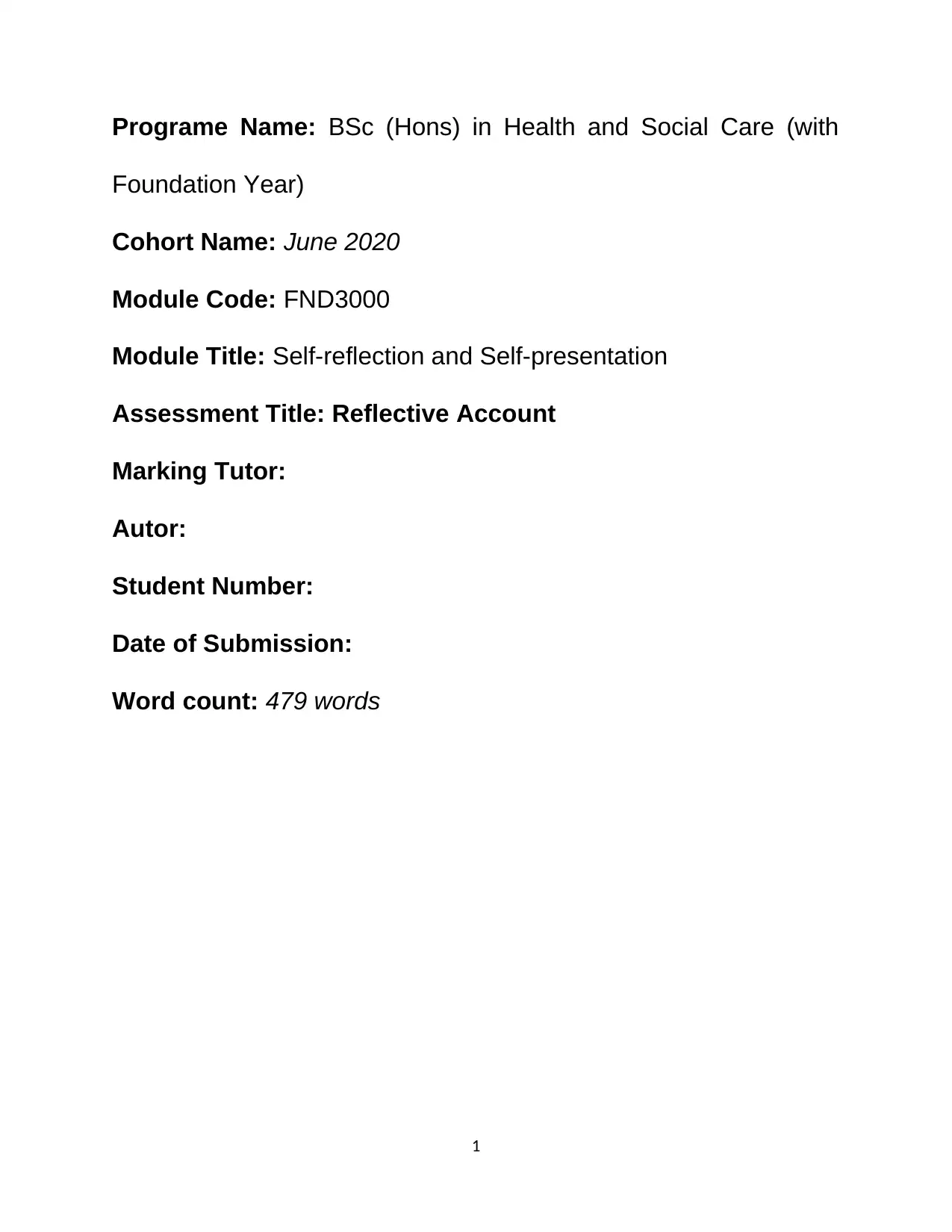
Programe Name: BSc (Hons) in Health and Social Care (with
Foundation Year)
Cohort Name: June 2020
Module Code: FND3000
Module Title: Self-reflection and Self-presentation
Assessment Title: Reflective Account
Marking Tutor:
Autor:
Student Number:
Date of Submission:
Word count: 479 words
1
Foundation Year)
Cohort Name: June 2020
Module Code: FND3000
Module Title: Self-reflection and Self-presentation
Assessment Title: Reflective Account
Marking Tutor:
Autor:
Student Number:
Date of Submission:
Word count: 479 words
1
Paraphrase This Document
Need a fresh take? Get an instant paraphrase of this document with our AI Paraphraser
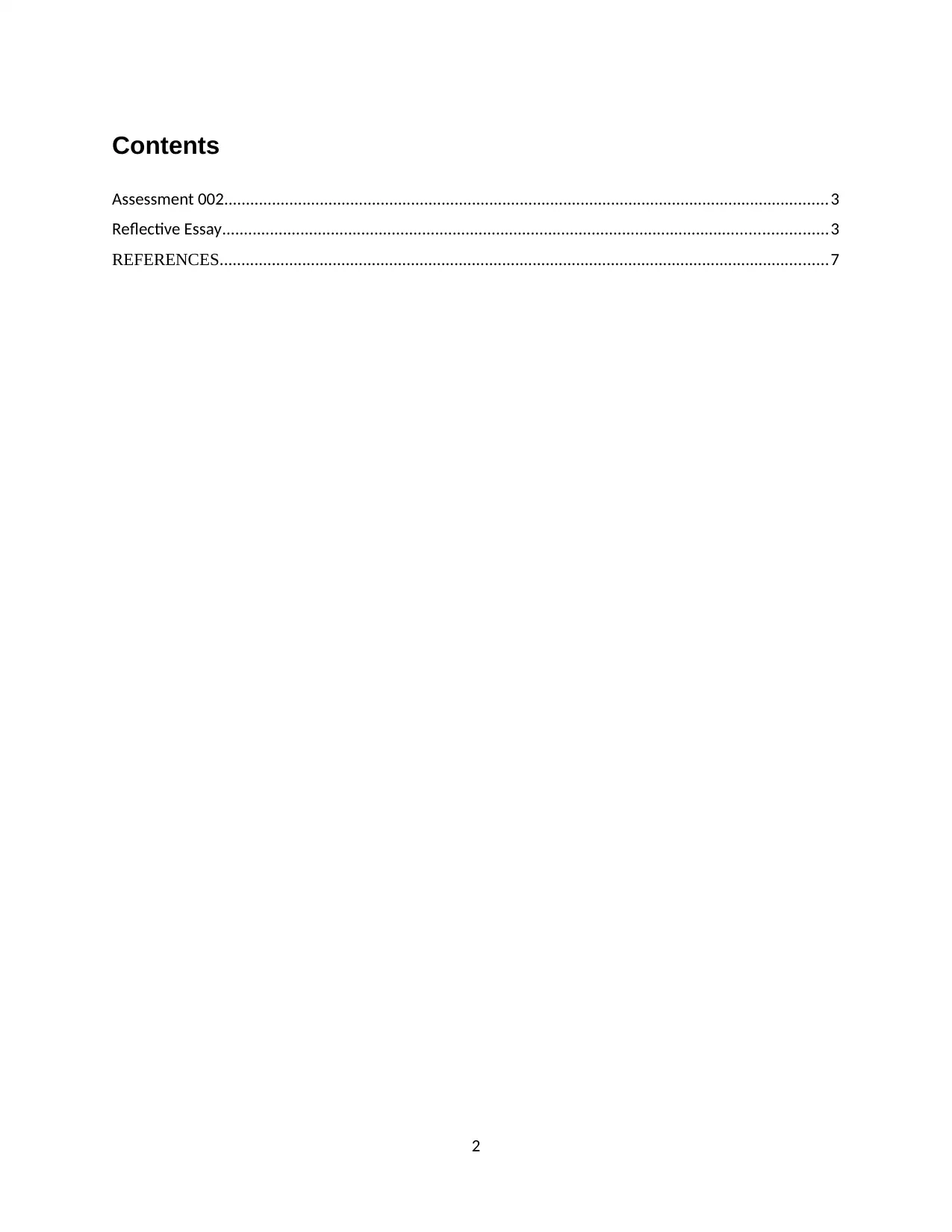
Contents
Assessment 002...........................................................................................................................................3
Reflective Essay...........................................................................................................................................3
REFERENCES............................................................................................................................................7
2
Assessment 002...........................................................................................................................................3
Reflective Essay...........................................................................................................................................3
REFERENCES............................................................................................................................................7
2
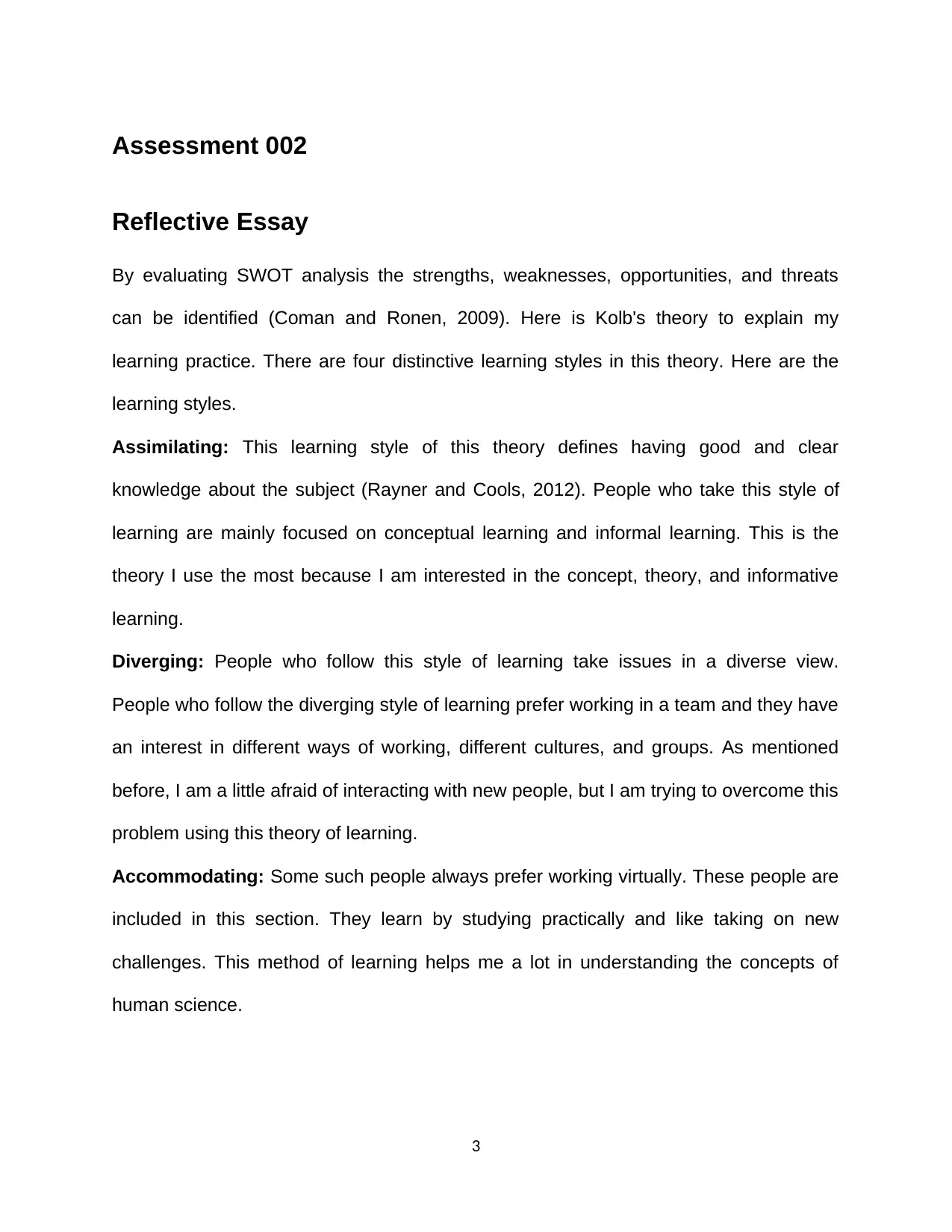
Assessment 002
Reflective Essay
By evaluating SWOT analysis the strengths, weaknesses, opportunities, and threats
can be identified (Coman and Ronen, 2009). Here is Kolb's theory to explain my
learning practice. There are four distinctive learning styles in this theory. Here are the
learning styles.
Assimilating: This learning style of this theory defines having good and clear
knowledge about the subject (Rayner and Cools, 2012). People who take this style of
learning are mainly focused on conceptual learning and informal learning. This is the
theory I use the most because I am interested in the concept, theory, and informative
learning.
Diverging: People who follow this style of learning take issues in a diverse view.
People who follow the diverging style of learning prefer working in a team and they have
an interest in different ways of working, different cultures, and groups. As mentioned
before, I am a little afraid of interacting with new people, but I am trying to overcome this
problem using this theory of learning.
Accommodating: Some such people always prefer working virtually. These people are
included in this section. They learn by studying practically and like taking on new
challenges. This method of learning helps me a lot in understanding the concepts of
human science.
3
Reflective Essay
By evaluating SWOT analysis the strengths, weaknesses, opportunities, and threats
can be identified (Coman and Ronen, 2009). Here is Kolb's theory to explain my
learning practice. There are four distinctive learning styles in this theory. Here are the
learning styles.
Assimilating: This learning style of this theory defines having good and clear
knowledge about the subject (Rayner and Cools, 2012). People who take this style of
learning are mainly focused on conceptual learning and informal learning. This is the
theory I use the most because I am interested in the concept, theory, and informative
learning.
Diverging: People who follow this style of learning take issues in a diverse view.
People who follow the diverging style of learning prefer working in a team and they have
an interest in different ways of working, different cultures, and groups. As mentioned
before, I am a little afraid of interacting with new people, but I am trying to overcome this
problem using this theory of learning.
Accommodating: Some such people always prefer working virtually. These people are
included in this section. They learn by studying practically and like taking on new
challenges. This method of learning helps me a lot in understanding the concepts of
human science.
3
⊘ This is a preview!⊘
Do you want full access?
Subscribe today to unlock all pages.

Trusted by 1+ million students worldwide
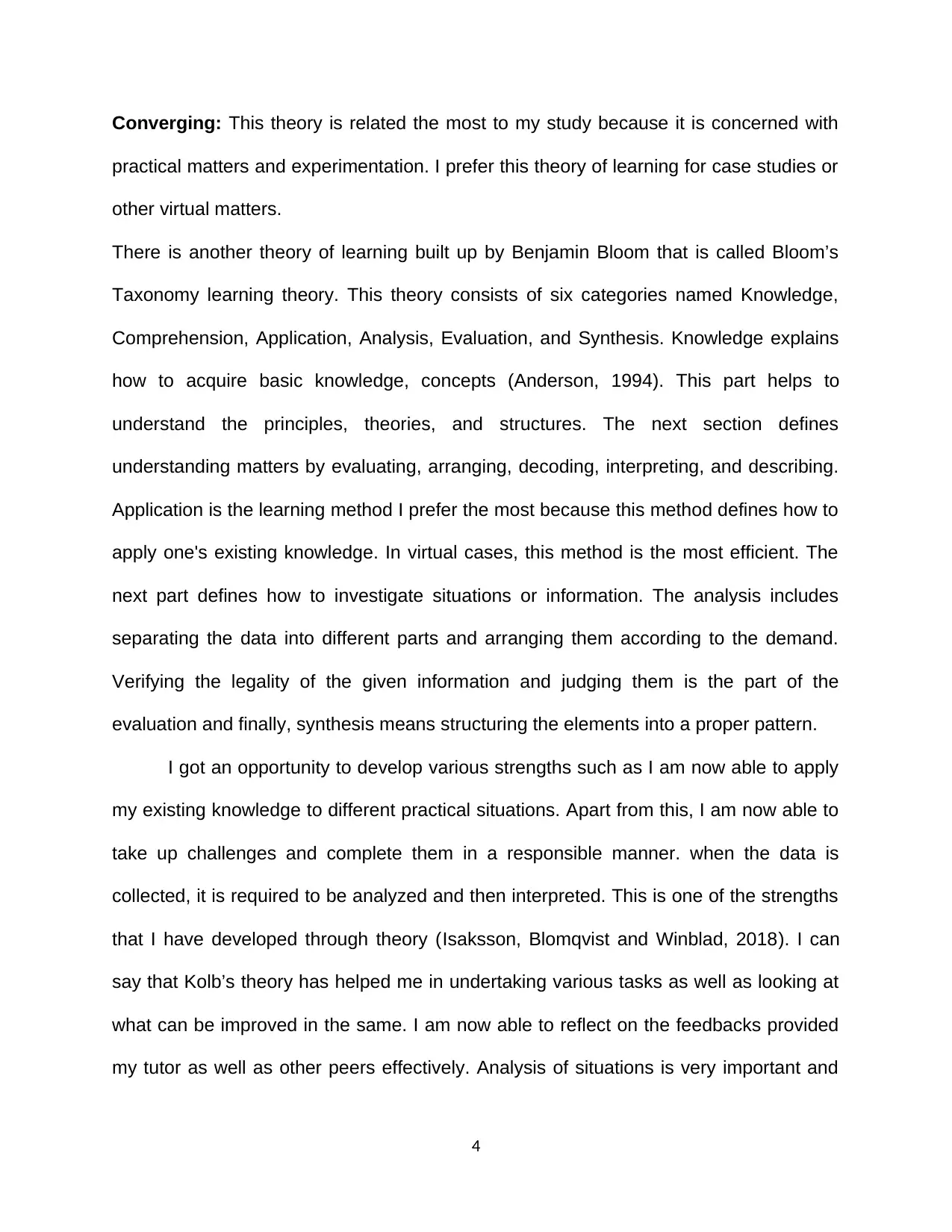
Converging: This theory is related the most to my study because it is concerned with
practical matters and experimentation. I prefer this theory of learning for case studies or
other virtual matters.
There is another theory of learning built up by Benjamin Bloom that is called Bloom’s
Taxonomy learning theory. This theory consists of six categories named Knowledge,
Comprehension, Application, Analysis, Evaluation, and Synthesis. Knowledge explains
how to acquire basic knowledge, concepts (Anderson, 1994). This part helps to
understand the principles, theories, and structures. The next section defines
understanding matters by evaluating, arranging, decoding, interpreting, and describing.
Application is the learning method I prefer the most because this method defines how to
apply one's existing knowledge. In virtual cases, this method is the most efficient. The
next part defines how to investigate situations or information. The analysis includes
separating the data into different parts and arranging them according to the demand.
Verifying the legality of the given information and judging them is the part of the
evaluation and finally, synthesis means structuring the elements into a proper pattern.
I got an opportunity to develop various strengths such as I am now able to apply
my existing knowledge to different practical situations. Apart from this, I am now able to
take up challenges and complete them in a responsible manner. when the data is
collected, it is required to be analyzed and then interpreted. This is one of the strengths
that I have developed through theory (Isaksson, Blomqvist and Winblad, 2018). I can
say that Kolb’s theory has helped me in undertaking various tasks as well as looking at
what can be improved in the same. I am now able to reflect on the feedbacks provided
my tutor as well as other peers effectively. Analysis of situations is very important and
4
practical matters and experimentation. I prefer this theory of learning for case studies or
other virtual matters.
There is another theory of learning built up by Benjamin Bloom that is called Bloom’s
Taxonomy learning theory. This theory consists of six categories named Knowledge,
Comprehension, Application, Analysis, Evaluation, and Synthesis. Knowledge explains
how to acquire basic knowledge, concepts (Anderson, 1994). This part helps to
understand the principles, theories, and structures. The next section defines
understanding matters by evaluating, arranging, decoding, interpreting, and describing.
Application is the learning method I prefer the most because this method defines how to
apply one's existing knowledge. In virtual cases, this method is the most efficient. The
next part defines how to investigate situations or information. The analysis includes
separating the data into different parts and arranging them according to the demand.
Verifying the legality of the given information and judging them is the part of the
evaluation and finally, synthesis means structuring the elements into a proper pattern.
I got an opportunity to develop various strengths such as I am now able to apply
my existing knowledge to different practical situations. Apart from this, I am now able to
take up challenges and complete them in a responsible manner. when the data is
collected, it is required to be analyzed and then interpreted. This is one of the strengths
that I have developed through theory (Isaksson, Blomqvist and Winblad, 2018). I can
say that Kolb’s theory has helped me in undertaking various tasks as well as looking at
what can be improved in the same. I am now able to reflect on the feedbacks provided
my tutor as well as other peers effectively. Analysis of situations is very important and
4
Paraphrase This Document
Need a fresh take? Get an instant paraphrase of this document with our AI Paraphraser
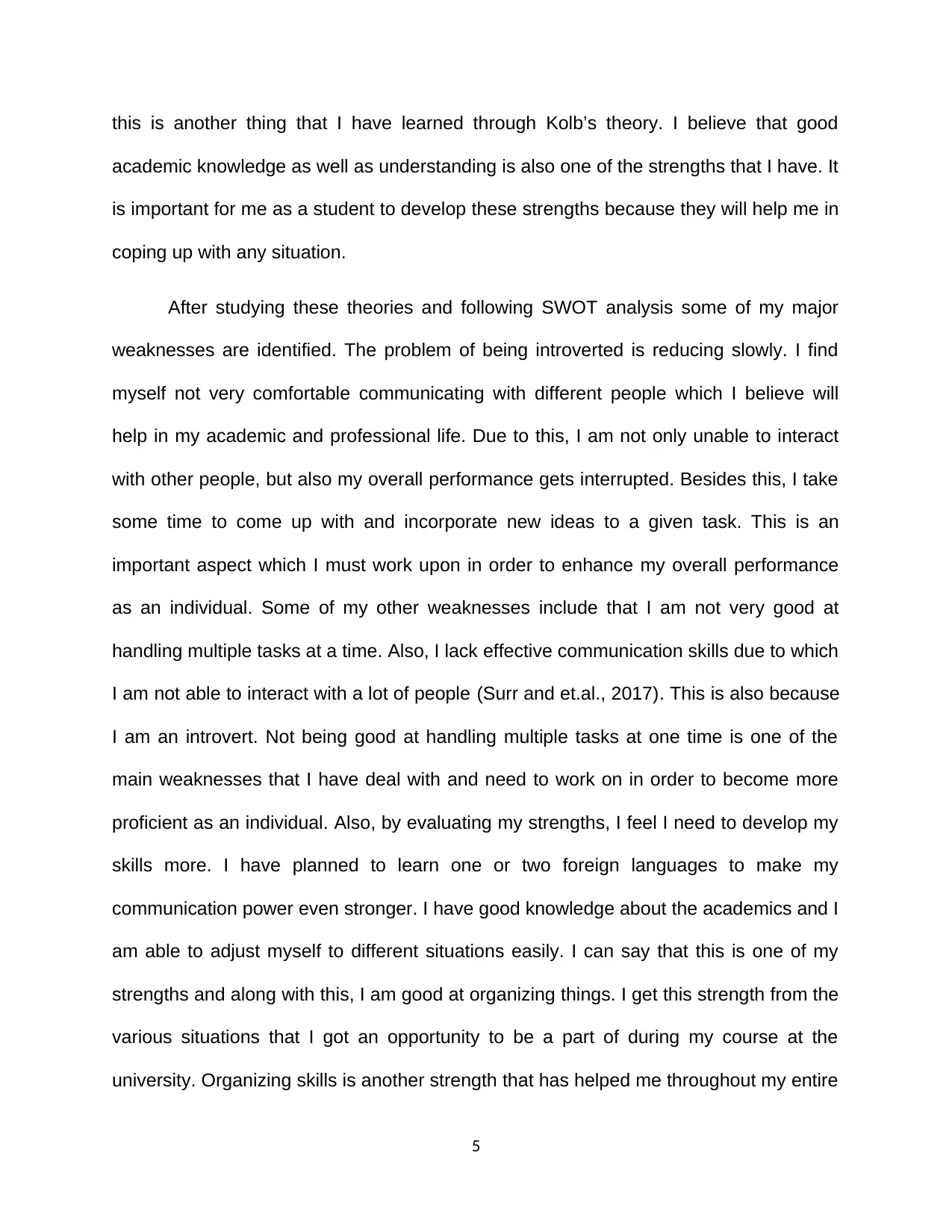
this is another thing that I have learned through Kolb’s theory. I believe that good
academic knowledge as well as understanding is also one of the strengths that I have. It
is important for me as a student to develop these strengths because they will help me in
coping up with any situation.
After studying these theories and following SWOT analysis some of my major
weaknesses are identified. The problem of being introverted is reducing slowly. I find
myself not very comfortable communicating with different people which I believe will
help in my academic and professional life. Due to this, I am not only unable to interact
with other people, but also my overall performance gets interrupted. Besides this, I take
some time to come up with and incorporate new ideas to a given task. This is an
important aspect which I must work upon in order to enhance my overall performance
as an individual. Some of my other weaknesses include that I am not very good at
handling multiple tasks at a time. Also, I lack effective communication skills due to which
I am not able to interact with a lot of people (Surr and et.al., 2017). This is also because
I am an introvert. Not being good at handling multiple tasks at one time is one of the
main weaknesses that I have deal with and need to work on in order to become more
proficient as an individual. Also, by evaluating my strengths, I feel I need to develop my
skills more. I have planned to learn one or two foreign languages to make my
communication power even stronger. I have good knowledge about the academics and I
am able to adjust myself to different situations easily. I can say that this is one of my
strengths and along with this, I am good at organizing things. I get this strength from the
various situations that I got an opportunity to be a part of during my course at the
university. Organizing skills is another strength that has helped me throughout my entire
5
academic knowledge as well as understanding is also one of the strengths that I have. It
is important for me as a student to develop these strengths because they will help me in
coping up with any situation.
After studying these theories and following SWOT analysis some of my major
weaknesses are identified. The problem of being introverted is reducing slowly. I find
myself not very comfortable communicating with different people which I believe will
help in my academic and professional life. Due to this, I am not only unable to interact
with other people, but also my overall performance gets interrupted. Besides this, I take
some time to come up with and incorporate new ideas to a given task. This is an
important aspect which I must work upon in order to enhance my overall performance
as an individual. Some of my other weaknesses include that I am not very good at
handling multiple tasks at a time. Also, I lack effective communication skills due to which
I am not able to interact with a lot of people (Surr and et.al., 2017). This is also because
I am an introvert. Not being good at handling multiple tasks at one time is one of the
main weaknesses that I have deal with and need to work on in order to become more
proficient as an individual. Also, by evaluating my strengths, I feel I need to develop my
skills more. I have planned to learn one or two foreign languages to make my
communication power even stronger. I have good knowledge about the academics and I
am able to adjust myself to different situations easily. I can say that this is one of my
strengths and along with this, I am good at organizing things. I get this strength from the
various situations that I got an opportunity to be a part of during my course at the
university. Organizing skills is another strength that has helped me throughout my entire
5
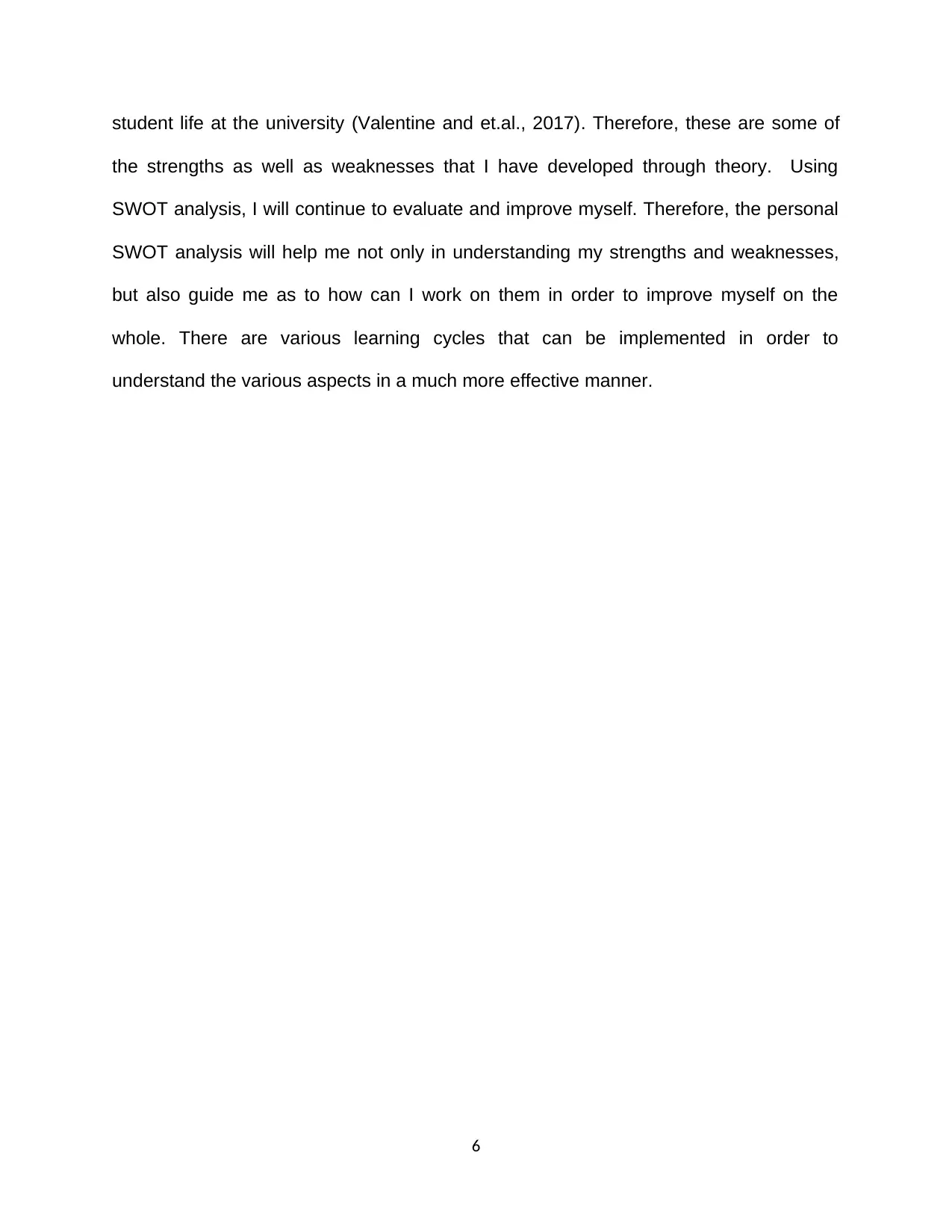
student life at the university (Valentine and et.al., 2017). Therefore, these are some of
the strengths as well as weaknesses that I have developed through theory. Using
SWOT analysis, I will continue to evaluate and improve myself. Therefore, the personal
SWOT analysis will help me not only in understanding my strengths and weaknesses,
but also guide me as to how can I work on them in order to improve myself on the
whole. There are various learning cycles that can be implemented in order to
understand the various aspects in a much more effective manner.
6
the strengths as well as weaknesses that I have developed through theory. Using
SWOT analysis, I will continue to evaluate and improve myself. Therefore, the personal
SWOT analysis will help me not only in understanding my strengths and weaknesses,
but also guide me as to how can I work on them in order to improve myself on the
whole. There are various learning cycles that can be implemented in order to
understand the various aspects in a much more effective manner.
6
⊘ This is a preview!⊘
Do you want full access?
Subscribe today to unlock all pages.

Trusted by 1+ million students worldwide
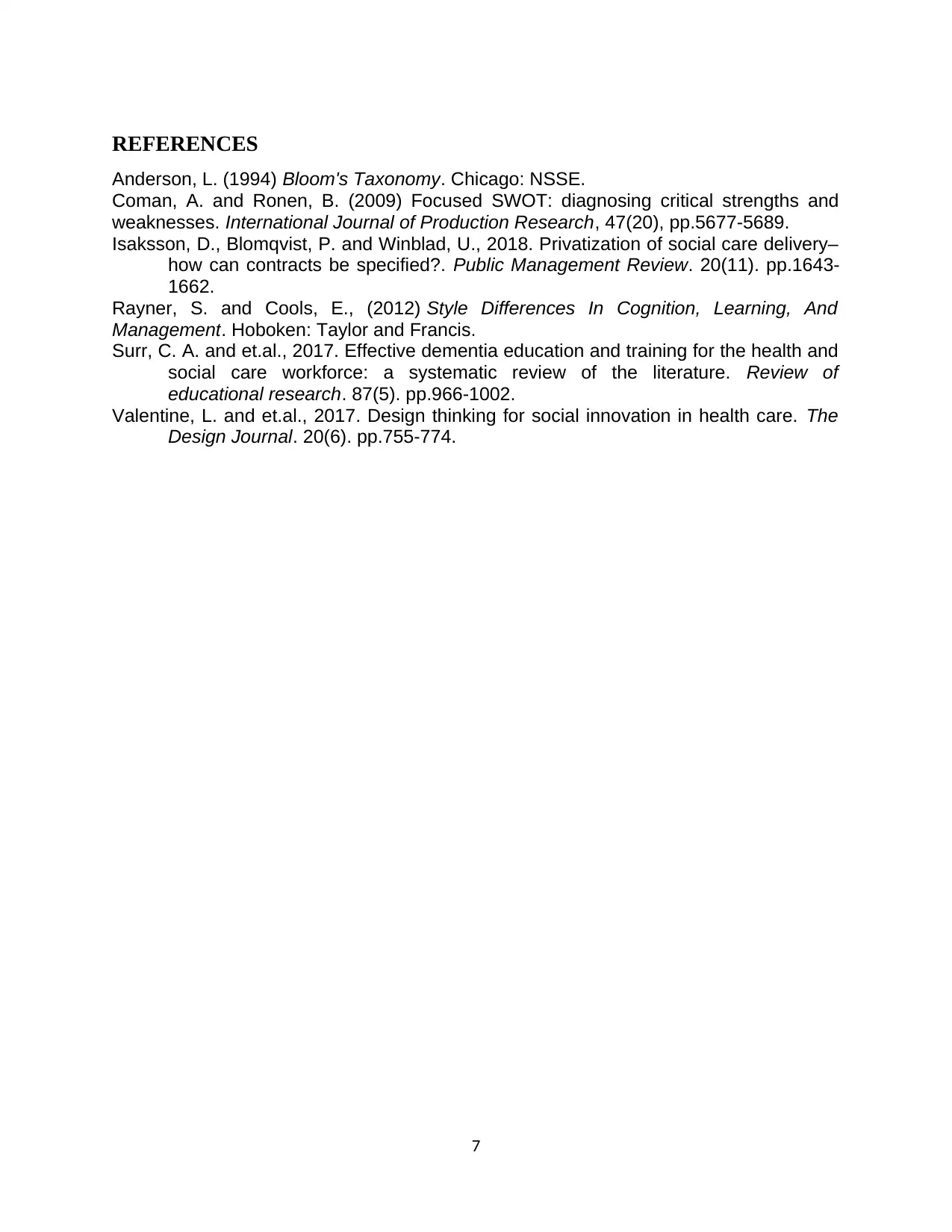
REFERENCES
Anderson, L. (1994) Bloom's Taxonomy. Chicago: NSSE.
Coman, A. and Ronen, B. (2009) Focused SWOT: diagnosing critical strengths and
weaknesses. International Journal of Production Research, 47(20), pp.5677-5689.
Isaksson, D., Blomqvist, P. and Winblad, U., 2018. Privatization of social care delivery–
how can contracts be specified?. Public Management Review. 20(11). pp.1643-
1662.
Rayner, S. and Cools, E., (2012) Style Differences In Cognition, Learning, And
Management. Hoboken: Taylor and Francis.
Surr, C. A. and et.al., 2017. Effective dementia education and training for the health and
social care workforce: a systematic review of the literature. Review of
educational research. 87(5). pp.966-1002.
Valentine, L. and et.al., 2017. Design thinking for social innovation in health care. The
Design Journal. 20(6). pp.755-774.
7
Anderson, L. (1994) Bloom's Taxonomy. Chicago: NSSE.
Coman, A. and Ronen, B. (2009) Focused SWOT: diagnosing critical strengths and
weaknesses. International Journal of Production Research, 47(20), pp.5677-5689.
Isaksson, D., Blomqvist, P. and Winblad, U., 2018. Privatization of social care delivery–
how can contracts be specified?. Public Management Review. 20(11). pp.1643-
1662.
Rayner, S. and Cools, E., (2012) Style Differences In Cognition, Learning, And
Management. Hoboken: Taylor and Francis.
Surr, C. A. and et.al., 2017. Effective dementia education and training for the health and
social care workforce: a systematic review of the literature. Review of
educational research. 87(5). pp.966-1002.
Valentine, L. and et.al., 2017. Design thinking for social innovation in health care. The
Design Journal. 20(6). pp.755-774.
7
1 out of 7
Related Documents
Your All-in-One AI-Powered Toolkit for Academic Success.
+13062052269
info@desklib.com
Available 24*7 on WhatsApp / Email
![[object Object]](/_next/static/media/star-bottom.7253800d.svg)
Unlock your academic potential
Copyright © 2020–2025 A2Z Services. All Rights Reserved. Developed and managed by ZUCOL.





